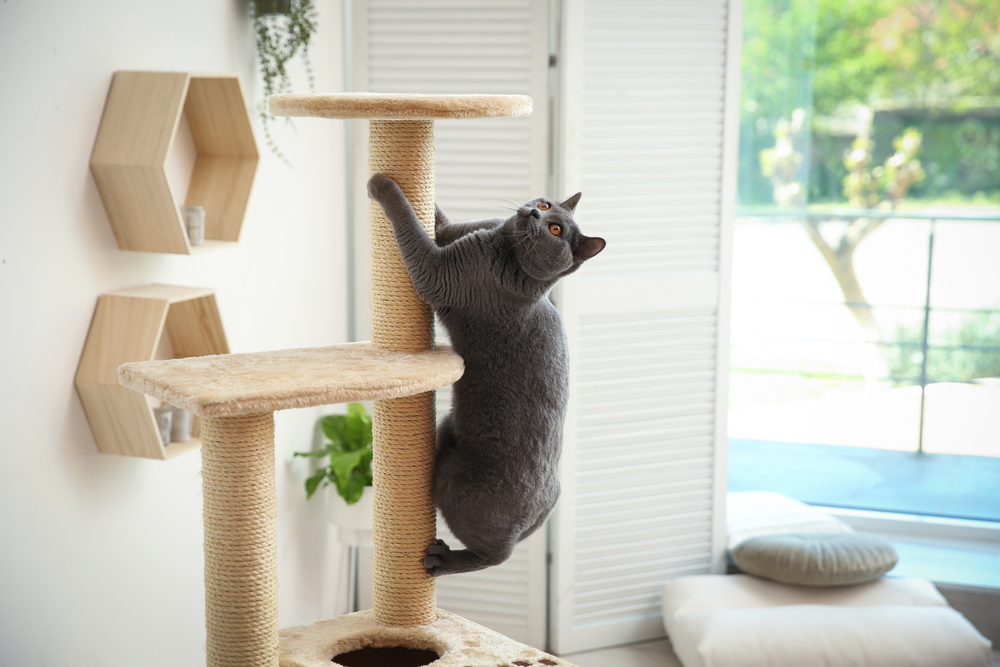Indoor cats may not have the opportunity to roam and hunt like their outdoor counterparts, but they can still lead fulfilling lives. Understanding their natural behaviors and providing mental enrichment can ensure your indoor cat stays mentally and physically stimulated. Our team at Shuler Veterinary Clinic offers tips that will help your curious kitty explore their natural behaviors and help ensure happiness and well-being.
All cats—from wild cats who chase after prey to indoor cats who bat and “kill” their toys—are natural hunters, and their stalking and hunting instincts remain, despite the thousands of years since they were domesticated. You can help provide them with indoor enrichment to keep them moving and living life to the fullest with the following seven tips:
- Let them climb — Cats love to climb and perch on high places, such as shelves, cat trees, and furniture tops. Consider buying a few cat trees or installing shelves that you keep clutter-free, where they can hang out and enjoy the view. They may not be tall trees, but your pet can climb and fulfill this instinct.
- Let them hide — Your cat will enjoy curling up incognito and observing their surroundings. Good hiding spots include cardboard boxes, cat tunnels, or covered beds where your cat can retreat when they need some alone time. Hiding spots help them behave naturally, feel more secure, and build their confidence.
- Let them have new toys — Keep your cat entertained by rotating their toys regularly with new ones. Some great options include laser pointers, feather-stringed toys, and cat dancers that mimic prey and help satisfy your cat’s hunting instincts. These interactive toys will also burn off some of that zoomie feline energy and help them stay in good physical shape.
- Let them play — Dedicate regular—ideally, daily—play sessions with your whiskered pal. Use interactive feather toys or laser pointers or satisfy their prey drive with plenty of stuffed mice toys to chase. These sessions also will provide physical exercise and the satisfaction of predatory behavior—and will strengthen your bond.
- Let them think — Instead of feeding your cat from a traditional bowl, use food puzzles or interactive feeders to make mealtime more engaging. These items encourage problem-solving and help to mentally stimulate your cat. Make your cat’s environment more interesting by periodically rearranging furniture or adding new hiding spots and toys to prevent boredom and encourage exploration. However, do this judiciously, because too many changes will cause your cat stress and anxiety.
- Let them explore — Train your cat to use a harness and leash to ensure their outdoor safety and then let them investigate the backyard while you supervise. You can also provide a secure outdoor enclosure (e.g., a catio) to protect your cat from potential dangers, such as traffic or predators. If your cat resists the harness and leash, they can still enjoy watching the world go by on a window perch or secure shelf. A comfortable bed or perch placed where they can enjoy the view from a window will also entertain and stimulate.
- Let them scratch — Cats instinctively scratch to keep their nails tidy and less sharp for grooming and to mark their territory. Of course, you don’t want them to scratch the furniture, so you must provide appropriate scratching items, which come in various forms, including cat posts, mats, and products that hang on a door knob. You can entice a reluctant cat to scratch by placing some catnip on or around the scratching posts or pads.
By understanding and accommodating your indoor cat’s natural behaviors, you can help ensure they lead a fulfilling, enriched life. Our team at Shuler Veterinary Clinic emphasizes enrichment as a critical component of your cat’s quality of life.
If your cat is climbing the curtains or destroying the furniture, call us to schedule an appointment. We can determine whether your cat is bored and give you more information on helping your cat express their natural behaviors.









Leave A Comment